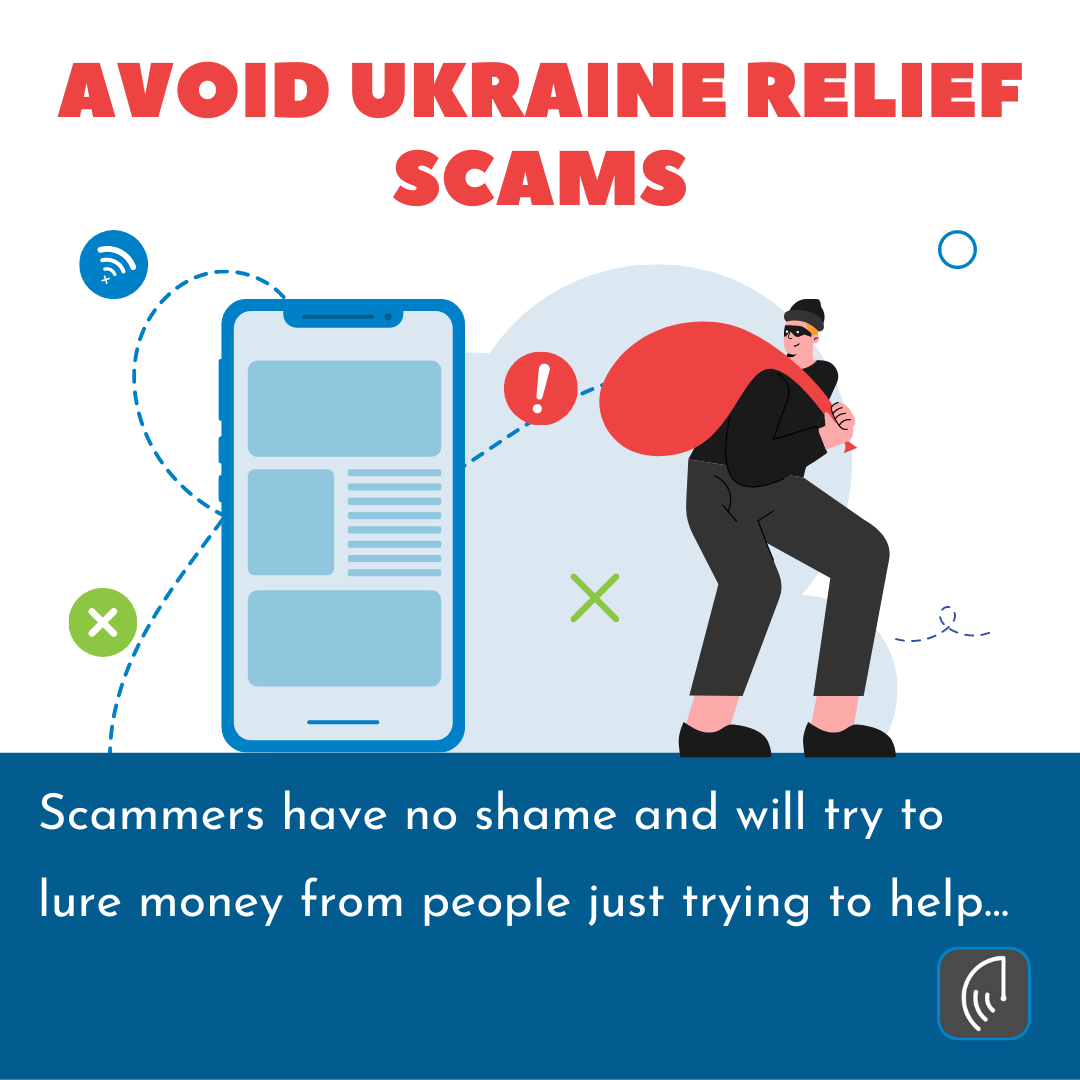
by Brian Thompson | Feb 28, 2022 | General, Identity Theft
As we continue to see the Russian invasion of Ukraine, it is natural that we look for ways to help. Donating money is often one of the best and easiest ways to make an impact. Unfortunately, we need to ensure that we avoid Ukraine relief scams popping up which is causing more chaos.
Scammers have no shame and will try to lure out money from people like you who are just trying to help. Below are some tips to consider while looking to help.
Donation Tips
-
Give to Organizations You Trust:
Do your research before giving. Review the charity’s purpose and find out how the charity spends its donations. How much is spent directly on the charitable cause? How much goes to overhead and employee compensation? You should also confirm the charity’s name, address, and nonprofit status.
-
Be Wary of Social Network Fundraising:
If you are planning to donate through a social network solicitation, first do some research. Find out what percentage is going to the charity, whether you will be charged a fee, or if a percentage of your donation will be paid to the platform website.
-
Don’t Be Pressured by Telemarketers – Ask Questions Before Donating:
If you receive a call from a telemarketer, ask for the name of the fundraising organization, whether it is registered with the Attorney General’s Office, the name of the charity benefitting from the solicitation, how much of your donation will go to charity and how much to the telemarketer, and the direct telephone number of the charity. Don’t fall for pressure tactics or threats. Remember that you have the right to say no and if you feel pressured or threatened, just hang up.
-
Watch Out for Similar-Sounding Names, Web Addresses, and Other Deceptive Tactics:
Fraudulent organizations may use names that closely resemble those of well-established charitable organizations in order to mislead donors. Look out for fraudulent websites that have a slightly different web address (URL) than that of a legitimate charitable organization. Similar-looking URLs are sometimes purchased by fraudsters to lure in would-be donors. These sites may ask you for personal information or install harmful material onto your device. Be skeptical if someone thanks you for a pledge you never made, and always check your records.
-
Understand the Difference Between “Tax-Exempt” and “Tax-Deductible”:
Being a nonprofit does not mean the organization is exempt from taxation, or that your donation is tax-deductible. Generally, a tax-exempt organization is exempt from paying tax on its income/gifts, but may or may not be able to offer tax deductions to donors. Just because an organization has a “Tax ID Number” doesn’t mean it is a charity, tax-exempt, or tax-deductible. A few tax-exempt organizations – 501(c)(3) tax-exempt status – are able to offer charitable tax deductions for your donations. If you are not sure whether your donation is tax-deductible, verify the charity’s tax-exempt status by using the tools and information located on the IRS website.
-
Protect Your Identity:
Never give your Social Security number or other personal information in response to a charitable solicitation. Never give out credit card information to an organization unfamiliar to you. Some organizations sell or rent their donor lists to other organizations, including organizations that are not charities.
Please consider sharing this with others, you may be helping others avoid Ukraine relief scams!

by Brian Thompson | Feb 9, 2022 | Breach, Identity Theft, Uncategorized
Two years ago I wrote an article asking the question Is Your Digital Identity Safe? Two days ago I read an Infosecurity Magazine article stating Identity Theft Will Get Worse. It appears that Hackers are coming after you in 2022!
Specific to your digital identity and today’s threat landscape for consumers and small businesses, cyber thieves and ID theft criminals have evolved to the point where hacking and data breaches will happen at any time and can affect anyone.
As for the statement “identity theft will get worse,” the fact is that 2021 surpassed the all-time record for data breaches exposing the Personally Identifiable Information (PII) of millions of Americans.
As a reminder, examples of PII include:
- Name: full name, maiden name, mother’s maiden name, or alias
- Personal identification numbers: social security number (SSN), passport number, driver’s license number, taxpayer identification number, patient identification number, employee or student identification number, financial account, or credit card number
- Address information: street address, or email address
- Telephone numbers
- Personal characteristics: photographic images (particularly of face or other identifying characteristics), fingerprints, or handwriting
- Biometric data: retina scans, voice signatures, or facial geometry
- Information identifying personally owned property: VIN number or title number
- Asset information: Internet Protocol (IP) or Media Access Control (MAC) addresses that consistently link to a particular person
And now our digital world, combined with a two-year pandemic, has consumers and small businesses worried. There is so much uncertainty in our world and cybercriminals, and their new scams are adding to the challenge.
Consumer?
If you are a consumer, recent digital risk examples making today’s headline news include How to avoid buying fake Covid tests online and BBB warns consumers of hackers posing as apps like Paypal and Venmo to steal your money.
Cyber thieves and ID theft criminals depend on human nature and emotion such as an individual’s tendency to trust others (e.g. phishing and vishing) and desperation (e.g. the chaos of supply chain shortages such as Covid-19 tests). These phishing and vishing tactics and fake websites have gained attention in recent weeks over the increasing number of identity theft victims.
Small Business Owner?
If you are a small business owner – trusting others and desperation are common risk factors just like a consumer – but it gets worse as Cyber risks top worldwide business concerns in 2022.
According to the just-released 12th Annual Allianz Risk Barometer Survey, cyber incidents at the top of the list. This is only the second time cyber has been at the top of the list in the survey’s history.
Cyber incidents, ransomware attacks, data breaches, or major IT outages worry businesses more than anything else. They worry businesses even more than a business interruption, supply chain disruption, or the COVID-19 pandemic.
To conclude, cyber thieves and ID theft criminals continue to find new and innovative ways to steal your personal information.
Both consumers and small business owners need to keep security education and awareness top of mind. Protecting our digital identities is crucial because hackers are coming for you in 2022.
Mark Pribish

by Brian Thompson | Jan 24, 2022 | Identity Theft
“I didn’t know Agents offer Identity Theft Protection?”.. this is a statement I often hear when we tell people about identity theft protection as an employee benefit.
Most of our partner agents say that many of their clients are unsure of how they are exposed to cybersecurity losses, what cyber services are available as part of an ID theft protection program, or that they underestimate the threat. Also indicating that they just didn’t know Identity Theft Protection was a benefit they could even offer!
If we are serious about protecting our clients and their employees we need to first understand why we as agents need to offer this service in the first place.
The Problem Your Clients Already Face
The reality is that employees are already getting their information stolen and it is impacting employees. We get it though, the costs of benefits seem to constantly increase, and running a business is getting more and more expensive. BUT employers are already paying the price of identity theft due to absenteeism and lost productivity from employees who have had their identity stolen.
*Impacts of ID Theft on Employees:
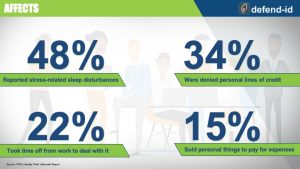
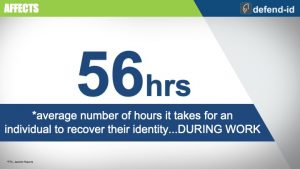
Realities of Identity Theft – Article
The Solution you have for clients
Identity theft protection can be a simple, low-cost, high-value solution. A solution that will protect the company and its employees from the impacts of identity fraud. Businesses Struggle with Rising Costs of Identity Theft – Article
But what does it do for you as an agent?
Yes, all of the things listed above are great reasons alone to offer the program. But, offering identity theft protection solutions as an agent can do many things for you and your business.
Our goal at defend-id is, yes to provide peace of mind with a place to turn for employees, but also to give you a simple solution to an ever-growing problem.
We want to provide you with another line of business to increase retention which increases revenue and recurring revenue for more years to come.
And we want to give you a new reason to reach out, to market your services with new clients or with clients you may have lost in the past – get your foot in the door and add other lines of business.
“I didn’t know Agents offer Identity Theft Protection?”.. this is a statement we do not have to hear. We, who have an opportunity to protect our clients further, can help protect our clients. We can turn this question around, “Did you know we offer identity theft protection as an employee benefit?” Now we are ahead of the curve, offering the best, timely products in the industry. Let us help you get there, it is simple to get appointed and easy to enroll your groups!
Become an appointed defend-id agent today!
*ITRC’s Aftermath Report

by Brian Thompson | Dec 9, 2021 | Breach, Identity Theft
The last two years have created an opportune environment for bad actors ensuring the Cyberdemic will continue into 2022.
As we continue to migrate our lives into the digital world with remote workforces and comfort we increase cybercriminals’ opportunity for attack. This year we have seen a significant shift in the focused attacks on supply chains, home networks, and a gigantic increase in healthcare breaches.
In its latest Data Breach Industry Forecast released Monday, Experian has 5 predictions that underscore the ongoing impact of the pandemic on cybersecurity. Criminals will continue to focus on the remote workforce, the healthcare system, and will begin to narrow their targets to exploit the weakest technologies.
5 Breach Trends for 2022
- Remote Workforce
Those working from home will certainly be targets for those looking to hack into your business. According to the report, home wireless networks are more vulnerable than business VPN’s. Businesses will need to focus on securing employee connections and education.
- Infrastructure
Biden’s infrastructure bill and the trillions of dollars approved by Congress will be a target. Electrical grids, dams, and transportation networks will be heavily targeted by foreign and domestic cybercriminals. Criminals will likely be looking to target funds at disbursement by using phishing and CEO fraud.
- Digital Assets
Cryptocurrencies and NFT’s (Non-Fungible Tokens)– will become greater targets for hackers as they gain more popularity. As we begin to understand and accept these assets as normal and useful, so will the criminals. Chances are, they are just waiting to realize their worth and inevitability.
- Natural Disasters
Natural disasters often bring out the best in those doing their best to help. People will donate to organizations that aim to give aid and help those who have been affected. Criminals will take advantage of our distress and target charitable giving by phishing and masking themselves as the organizations we trust. To complicate things further, supply chains will be broken and unreliable, making important emergency goods difficult to source… another vulnerability that hackers will exploit.
- Gambling
As more and more states are legalizing gambling, phishing scams will target the growing online gambling community. Common scams will include stolen credit card information, account hijacking, or creating sites that appear to be legitimate casinos.
The Identity Theft Resource Center reports that there have been 1,291 breaches in 2021 as of September. There were 1,108 in all of 2020, which is a 17% increase in just three quarters of the year.
The past two years have caused so many disruptions in our way of living and working but we need to increase our personal and professional focus on privacy. As a result, the Pandemic has created an abundance of opportunities ensuring the Cyberdemic will continue into 2022.
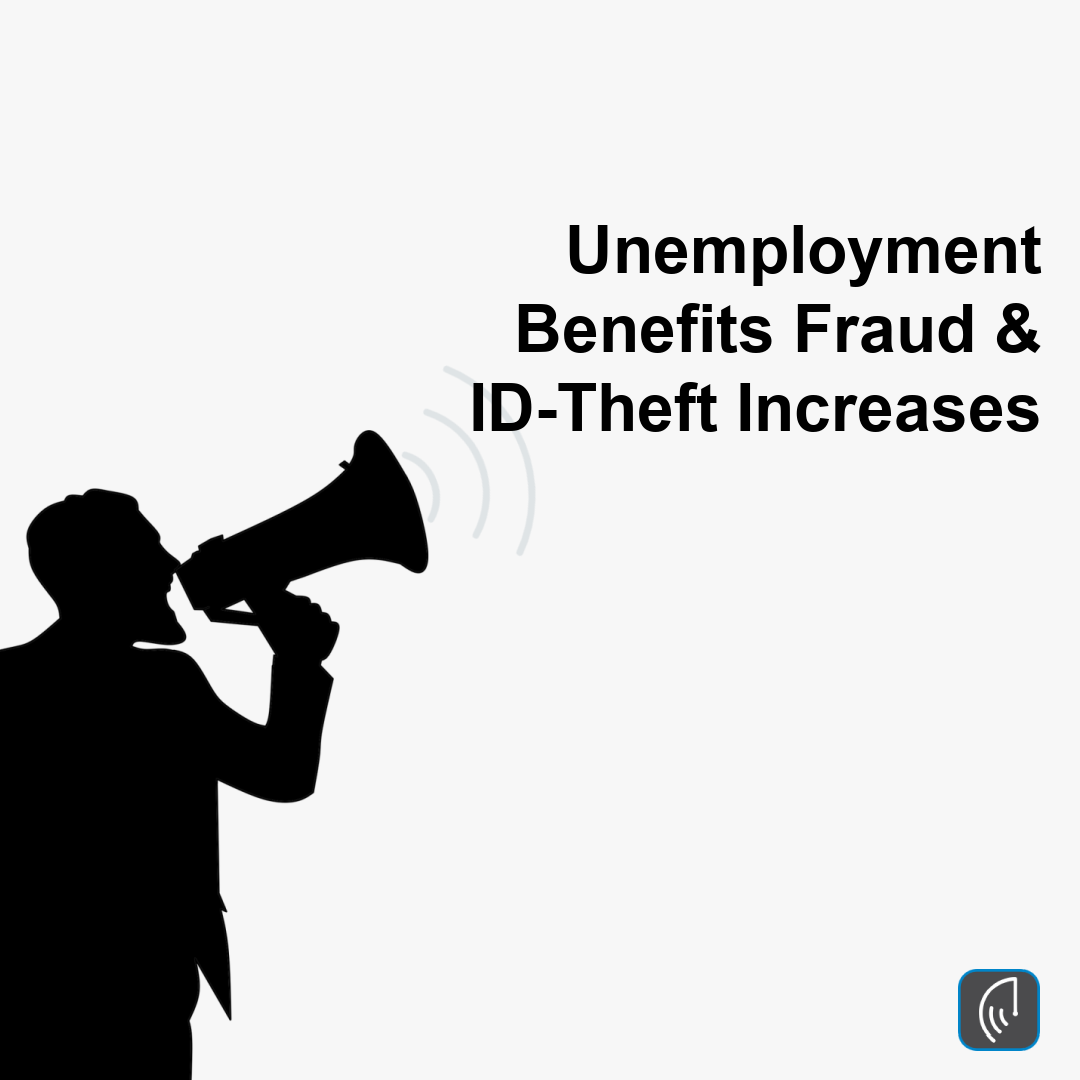
by Brian Thompson | Nov 17, 2021 | Identity Theft
The pandemic is proving to bring the expected Unemployment Benefits Fraud & ID-Theft increases predicted by experts.
There were indications early on that there would be a problem with an increase in fraud during the pandemic. As with most issues of mass concern comes the opportunity for bad actors to take advantage of the system and people. With COVID-19 we have seen exactly that, an increase of fraud at epic levels.
Have you been a target?
The phone rings, “Hi Jane, this is Bill calling from XYZ Auto Warranty. I see that your auto warranty has expired and I was calling to see…”. Or have you received a debit card in the mail that you never applied for? Have you gotten a letter asking for additional details for the unemployment application that you never filed?
If any of these have happened to you, you are likely a target.
But why an increase in unemployment fraud?
Unemployment benefit fraud during the pandemic provided the bad guys a huge opportunity. That said the problems that actually cause the increase of fraud have not changed and will not go away because the special COVID benefits have ended. State systems buckled under the weight put on them by the tsunami of layoffs. States had to process millions of applications, including new program applications established by the CARES Act.
Yes, the rate of layoffs and new applications for unemployment have slowed down. But the rate of fraud attempts have not slowed down, and have unfortunately slowed down legitimate claims. The defend-id recovery team, who assist identity theft victims, indicate that they are still receiving daily calls about unemployment fraud. In some instances, they have lost their job and applied for unemployment benefits but have been denied. They are being denied because someone else has fraudulently already done so.
Steps we take
When our clients, or your employees are faced with unemployment fraud we take the following steps to ensure recovery. These steps are taken on behalf of the employee/individual to ensure full and complete recovery.
Here is a step by step look at the recovery process.
Steps taken when there is unemployment fraud:
- An identity theft case will be opened and assigned to a dedicated Recovery Advocate (RA)
- Then the RA will report the fraudulent unemployment insurance claim to the department of labor with the appropriate state
- Then the RA will ensure the employees credit monitoring is active- (not all employees will activate their services so we will help them do that at time of claim)
- This will provide early detection of potential fraud during recovery and into the future
- The RA will provide a 3-bureau credit report
- RA will review the report to ensure it’s accurate and rule out additional fraud or identity theft
- Fraud alerts will be placed with all 3 bureaus on the id theft victim’s behalf and/or provide them with information regarding a complete security freeze
- Victims will recieve an email with a fraud letter, recapping what they have completed on their behalf and the email provides the victim the direct contact information of their RA
- The RA will follow up with the employee to ensure they were able to complete monitoring (if not already completed) and if they have any additional questions or concerns for 12 months.
Please let these be a guide for you or if you want assistance do not hesitate to reach out to one of our team members for help.
Continue to keep an eye on your credit reports, bank accounts, mail and email for new financial or personal activity that seems funny or out of place. If it does seem out of place take steps to understand and do not ignore the signs… it could be Unemployment Benefit Fraud & ID-Theft
Related article: Tax & Unemployment Fraud at Epidemic Levels
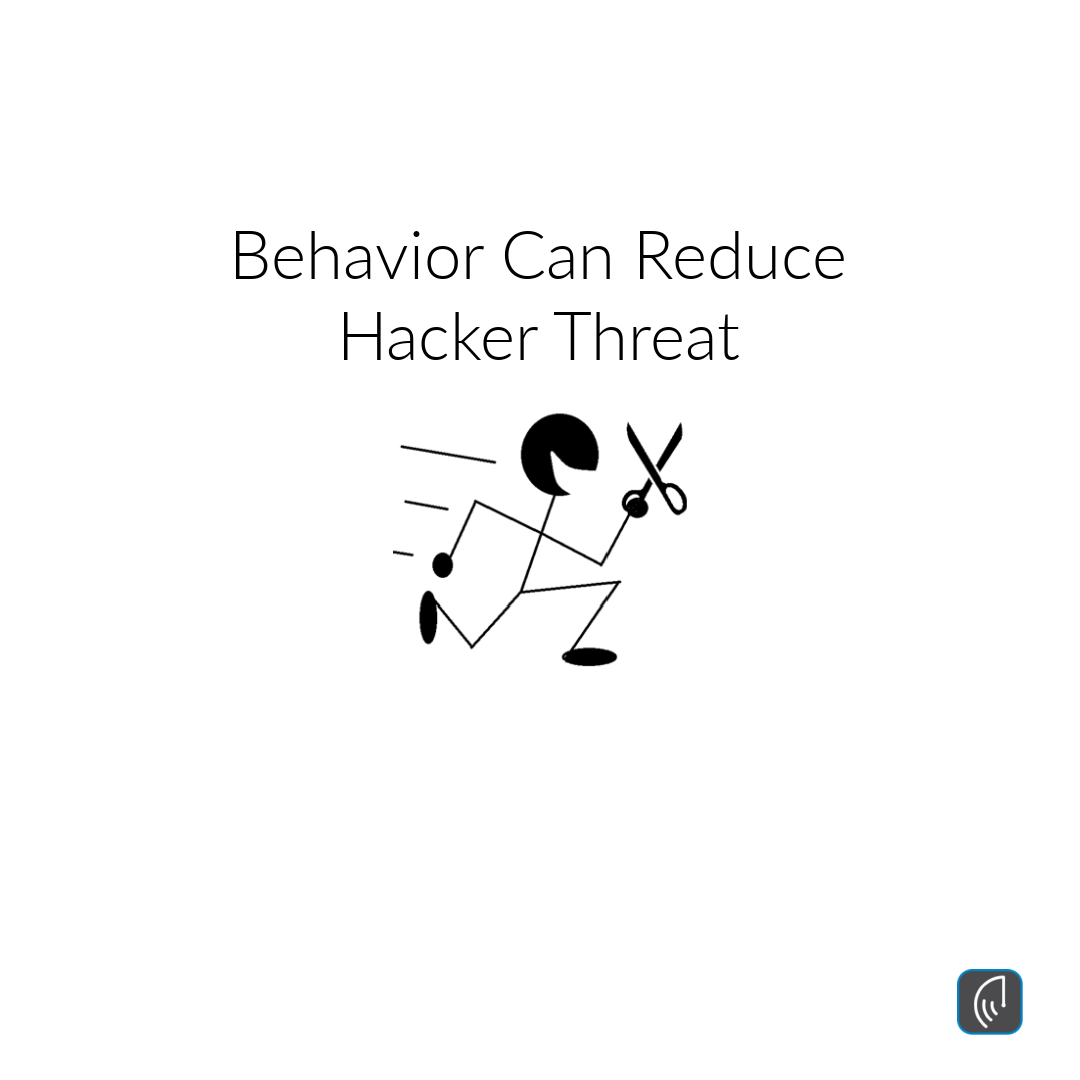
by Brian Thompson | Sep 1, 2021 | Breach, Identity Theft
Consumer behavior can help reduce the hacker threat we are all facing. With education and awareness, we can not only protect ourselves but the companies we work with and for.
Author (Matt Burgess) of Wired UK Magazine recommends six action items for consumers to help protect themselves including (6 Things You Need to Do to Prevent Getting Hacked | WIRED):
- The use of multi-factor authentication
- Password manager
- Learn how to spot a phishing attack
- Update/backup everything
- Encrypt everything and
- Wipe your digital footprint.
4 Personal Resolutions to help you
Nearly three years ago I published a similar article on January 18, 2019, titled 4 Personal Privacy Resolutions to Protect Yourself From ID Theft to help consumers with their privacy concerns, by writing about four resolutions including:
-
Social Media: you should reconsider the data you share on social media including Facebook, Twitter, Instagram, Snapchat, and even LinkedIn – as all five of these social media leaders have experienced one or more data breach events. Your resolution is to stop using social media, take a break, or reduce how much time you spend on it.
-
Password Management: using new and strong passwords is one of the best ways to protect yourself from identity theft. Using passwords that there are weak – and might even be used for multiple accounts, puts you at risk. Your resolution is to use a password manager that creates new, strong passwords. A PW manager will also scan existing passwords to flag reused and weak passwords.
-
Terms & Conditions: whenever I speak on the topics of cybersecurity, data breach, identity theft, and personal privacy – I always ask the audience “how many of you” have read the terms and conditions of your social media accounts or apps on your smartphones? The response is always zero. Your resolution is to read the terms and conditions of all new and current accounts. Reading T&C’s will help you understand what personal information that is being collected, used, and sold for marketing purposes.
-
Virtual Private Network (VPN): VPN software scrambles your IP address, encrypts data sent between your computer and the websites you visit, and masks your true location and service provider. This is important if you use public Wi-Fi. Your resolution to use a VPN will prevent hackers from seeing your traffic and potentially scraping sensitive information such as financial details. Public WiFi is Putting You at Risk
While I agree that consumers should be concerned about the recent T-Mobile data breach event where current and former customers are at a high risk of identity theft, consumers should be equally concerned about their behavior relating to social media, the internet of things, human error, and bad habits.
Consumer behavior can help reduce the threat of hackers but we have to educate ourselves and remain diligent.
By Mark Pribish
Vice President and ID Theft Practice Leader







